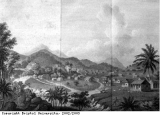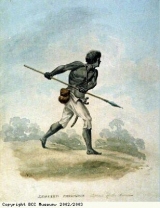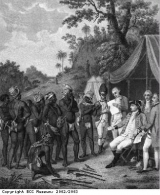The maroons of Jamaica
The Maroons were escaped slaves. They ran away from their Spanish-owned plantations when the British took the Caribbean island of Jamaica from Spain in 1655. The word maroon comes from the Spanish word ‘cimarrones‘, which meant ‘mountaineers’. They fled to the mountainous areas of Jamaica, where it was difficult for their owners to follow and catch them, and formed independent communities as free men and women.
As more slaves were imported from Africa to work on the developing sugar plantations, and the population of enslaved Africans grew on Jamaica, there were more rebellions by the slaves. Some of the rebel slaves disappeared into the mountains and joined the Maroon communities. As the Maroon population grew, the Jamaican government decided to defeat the Maroons once and for all. They were seen as a constant threat by the government. The First Maroon War began in 1728. The campaign against them made the Maroons more determined than ever. Under their leader called Cudjoe, the Maroons fought back. In 1739, the British and the Maroons made peace. The freedom of the Maroons was recognised and their land was given to them. The Maroons were to govern themselves. In return they would support the British government in Jamaica against foreign invasion and would help capture rebel slaves and runaways from the plantations and return them to their owners. Although this agreement might seem strange now, it was one way for the Maroons to live in peace with the island’s government.
Pictured here is a drawing entitled Pacification with the Maroon Negroes, dated 1801. It is an imaginary view of a meeting between British soldiers and Maroons. It is not clear whether it is meant to be of the 1739 or the 1795 peace agreement. The leaders of the Maroons did meet British officers to accept a peace agreement offered to them.
There were many years of peace between the Maroons and the British in Jamaica. But, in 1795, the new Governor of Jamaica, Balcarres, decided to deal with some minor breaches of the peace treaty by a community of Maroons called the Trelawney Town Maroons. The plantation owners asked the governor not to take action. They felt that an agreement should be reached with the Maroons to maintain the peace of the town. The governor went ahead against this advice, arresting several of the leaders of Trelawney Town. This started the Second Maroon War. 300 Maroons in Trelawney Town held out against 1500 troops and 3000 local volunteer troops. After five months of fighting, the undefeated Maroons were offered an agreement for peace. When they surrendered their arms, the Governor cheated on the peace agreement offered. The Maroons were arrested and, against the agreement they had accepted, were transported off the island to Nova Scotia, on the east coast of north America, and later went to Sierra Leone, West Africa. Leonard Parkinson was one of the leaders of the Maroons, he was active in the Second Maroon War. The local authorities put a price on his head of £50, (about £2,500 today), wanted dead or alive. Parkinson, pictured here, was known as the Captain of the Maroons.
Trelawney Town was the largest of the Maroon settlements on the island of Jamaica. The image pictured here of Trelawney Town shows the British soldiers riding in to attack the town. The Maroons are surrounding them, ready to resist, and would beat them back. Maroons were known for their skilful tactics in combat, whereby they relied on their knowledge of the surrounding environment to outwit the attackers.
With acknowledgment to Richard Hart for his work on the history of the Maroon community of Jamaica.





